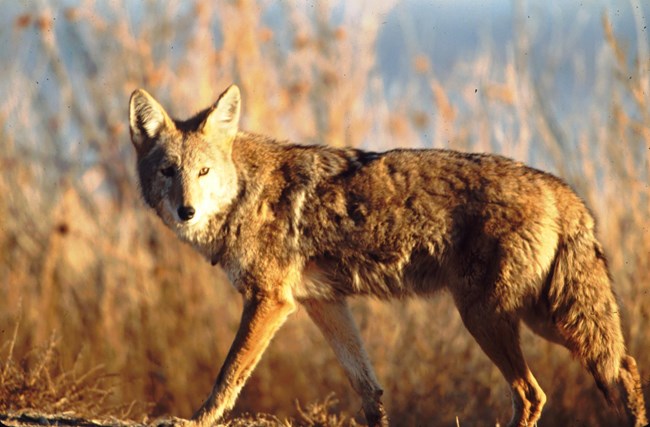
NPS Photo / Kim Acker
Wildlife is just as much a part of the Outer Banks as its iconic lighthouses and white sandy beaches. While most wildlife offers visitors and residents a quintessential seashore experience, some can be unwelcome but are still as much a part of the ecosystem and the Outer Banks are their home. Coyotes are not new to the Outer Banks, but the frequency of observation has increased in recent years. This is due to the animal's unique ability to adapt to a wide range of habitats, including suburban environments, along with the loss of their own habitat due to rapid human population growth across the state. For this reason, you may find coyotes wandering populated beaches and neighborhoods, some may even enter private yards and public parks. Coyotes are not going away; therefore, we must learn to coexist with the animal in a safe manner. Continue reading below to discover some quick facts about coyotes and how to prevent conflict and habituation. 
NPS Photo Coyote Quick Facts:Where did coyotes come from? Coyotes were once found only in the mid-western portion of North America. But as Europeans settled across the country, the subsequent landscape changes, couple with the elimination of wolves, allowed the coyote to expand its range toward the eastern United States. By the 1980s coyotes started to appear in western North Carolina as a result of natural range exapnsion from our neighboring states. Coyotes are now established in all 100 counties of North Carolina and live in many towns and villages. What do coyotes look like? Often described as a "mangy-looking dog," coyotes weigh about 20-25 pounds (similar to a mid-size dog) with, typically, reddish to dark gray thick fur. They have long slender snouts, a bushy and black-tipped tail, and pointed ears. Do they make noise? Yes, coyotes howl. While some find it unnerving, this howl serves many purposes, none of which are malicious. If you hear a family of coyotes howling, it is easy to think that the area is overflowing with coyotes. In reality, there are usually only 2-6 coyotes, including the pups. Will coyotes attack me or my child? Attacks on people, including children, are extremely rare. Normal coyote behavior is to be curious, but wary, when close to humans. Like other wildlife, they will become bold and habituated if people feed them, either purposely or inadvertently, such as with garbage or outdoor pet food. They rarely contract rabies. Will coyotes attack my pet? Possibly. Coyotes view outdoor cats and small unleased dogs as prey, while larger dogs are viewed as threats to their territory and/or their pups. Coyotes are most likely to confront larger dogs during the mating and pup birthing period, January through June. What should I do if I see a coyote? Simply seeing a coyote is not cause for concern. If you see a coyote frequently, you and your neighbors should take steps to prevent conficts with it and other wildlife. Preventing Conflicts with CoyotesTo prevent problems with coyotes:
|
Last updated: September 3, 2023
